 |
 |
 |
| City &
Highlight Sightseeing ::
Kerman ::
Highlights |
 |
 |
 |
 |
|
|
 |
|
 |
|
 |
 |
|
KERMAN
: |
 |
 |
|
ALL HOTELS &
GUESTHOUSES: |
|
   |
|
Kerman,
the capital of Kerman Province, located in an
altitude of 1, 860 m above sea level and 1,062 km to
the south of Tehran, is a wonderful place. Unless
one travels to Kerman by air, it seems a very long
way from any other center of importance, no matter
whether one approaches it from the northwest, the
southwest or the southeast.
Modern Kerman is connected to all such centers by
air (daily flights), railway and first-class asphalt
roads, on Tehran-Bandar Abbas-Zahedan routes. The
train station is 4 km southwest of Kerman and the
airport is also southwest, but the bus station
(terminal) is in the south.
The town is situated close to the wastes of Dasht-e
Lut, from which it is separated by a range of
mountains. Its name is probably derived from the
tribe of Germanioi listed by Herodotus. Believed to
have been founded in the early 3rd century AD by
Ardashir I, founder of the Sassanian dynasty, it was
from the 7th century ruled in turn by the Arabs, by
Buyids, the Seljuks, the Turkmans and the Mongols.
But it did not become famous for its carpets until
long after the time of Marco Polo (who mentions only
the skill of local leather workers, silk
embroiderers and armoreres in 1271), for the town
expanded rapidly under the Safavids in the sixteenth
and seventeenth centuries, both the English and
Dutch exporting Kermani carpets from the port of
Bandar Abbas.
Kerman has had a long and turbulent history, and it
has only for short spells enjoyed peace and
prosperity at the same time. Late in the 18th
century AD, Agha Mohammad Shah of Qajar dynasty took
a terrible vengeance on the people of Kerman because
they had given help to his mortal enemy Luft Ali
Khan Zand. The town has a Zoroastrian minority,
altogether much smaller than that in Yazid.
The pistachio, grown principally in the Rafsanjan-Kerman
area, is the most popular nut in Iran, though
walnuts, almonds, and hazel nuts are also eaten; so
too is melon seed, which has first to be adroitly
split with the teeth to extract the edible kernel. A
variety of nuts, seeds and dried fruits, known
collectively as ajil are eaten before and after
meals and particularly in Iranian parties.
Most of the ancient Kerman was destroyed in 1794
earthquake, and the modern Kerman radiates from two
squares (Azadi and Shariati), and all the monuments
of interest lie between these two, and include:
Annual
Temperature average:
|
JAN
|
FEB
|
MAR
|
APR
|
MAY
|
JUN
|
JUL
|
AUG
|
SEP
|
OCT
|
NOV
|
DEC
|
|
4.5
|
7.3
|
10.0
|
14.3
|
19.9
|
25.0
|
28.6
|
25.2
|
22.2
|
17.0
|
9.9
|
6.5
|
 |
 |
 |
| |
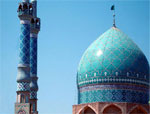
|
FriDay Mosque
Known also as the Masjid-e Jame this
14th century AD FriDay Mosque,
appropriately the greatest structure of
the city, is just off the main square (Shohada).
It is designed on the classical Iranian
model of four ivans, with wonderful blue
faience, if "blue" is not too vague a
term for the several shades from
turquoise to ultramarine that create a
vertical sea of smooth, shimmering
glittering mosaic-tile. The wall of the
mihrab and the central dome are also
decorated with admirable geometric
compositions, which Robert Byron
believed to be Yazd work of the 14th
century (although much of the present
structure dates from the Safavid
period). It is no problem for the
non-Muslim to go inside. In addition to
the mihrab, its magnificent portal and
the Kuffic inscription bearing the date
1349 AD, are worth seeing. On the
western side of the mosque there is an
ivan which originally dates from the
times of Al-e Muzaffar. However, the
mosque has been repaired in later
periods, including repairs of the main
part of its mihrab, carried out in the
reign of Shah Abbas II.
|
|
|
|
 |
 |
 |
 |
 |
 |
| |
|
|
Khajeh Atabeig Mausoleum
The historic mausoleum of Khajeh
Atabeing is a twelfth century building (
Seljuk period) in the south east of
Kerman, near Masjid-e Bazaar. Inside, it
looks a square building, while octagonal
from outside. Its gypsum moldings and
prettily patterned brickwork, costly
marble slabs and fine Kuffic
inscriptions are extremely worthy of
note. They include geometrical patterns,
detailed ornamentations, and a fine
style of columniation and stone
workmanship in the mihrab. The gypsum
moldings had been destroyed about fifty
years ago, however, repaired by the
Iranian Cultural Heritage Organization.
|
|
|
|
 |
 |
 |
 |
 |
 |
| |
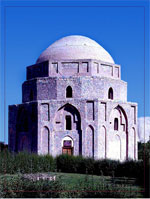
|
Gonbad-e Jabalieh
Gonbad-e Jabalieh (also known as the
Gonbad-e Gabri and Jabal-e Sang) is an
enormous tower standing quite on its own
on the north side of Shohada Avenue,
toward Masjid-e Saheb oz-Zaman, just
beyond the eastern end of Kerman. It is
of octagonal design and comprises three
floors crowned by a rather flat dome,
totally empty inside. It appears to
predate the 2nd millennium AD and may
have been a Zoroastrian building, and is
remarkable because of being constructed
of stone rather than the more usual
brick. The door is permanently locked,
although the tourist office might be
able to find someone to open it for you
if you really want to see inside. To get
there, take a shared taxi from Shohada
Square. The rocky outcrops over looking
the Martyrs Cemetery just south-east of
the Gonbad-e Jabalieh, offer a fine
outlook over Kerman, if only you manager
to climb to the top. It has been
repaired during the first decades of the
advent of Islam in Iran.
|
|
|
|
 |
 |
 |
 |
 |
 |
| |
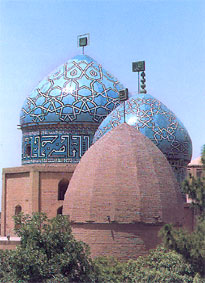
|
Gonbad-e Moshtaghieh
Standing to the east of Masjid-e Jame,
Gonbad-e Moshtaghieh of the early
nineteenth century (Qajar period), is
also known as the Seh Gonbad. It has got
very fine tile decorations in its
interior. The tower has been constructed
on three tombs belonging to Moshtagh
Alishah (a 19th century mystic), Sheikh
Esmail, and Kowsar Alishah. This Gonbad
has been repaired before the Islamic
Revolution. A costly manbar (pulpit) and
some rich plaster decorations on the
ceiling of the Gonbad and mural painting
constitute the main attractions of the
place.
|
|
|
|
 |
 |
 |
 |
 |
 |
| |
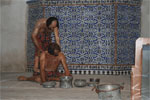
|
Ganj Ali Khan Bath and Ethnological
Museum
Look out for the Ganj Ali Khan Bath and
Ethnological Museum in the Vakil Bazaar
(now a traditional tea-house). This
building houses an interesting
exhibition of good waxworks of men in
various poses and costumes set in a
traditional but no longer operational
bathhouse. There is an insignificant
entry of 50 rials or so.
The Ganj Ali Khan Bath (hammam) is one
of the several ancient monuments and a
group of utilitarian buildings in Vakil
Bazaar dating from the Safavid period in
the 17th century. The Bath, named after
a former governor of the province, is
being kept as a real hammam, but its
life-size wax figures bring back the
memory of everyDay scenes of the past.
All garments and other objects exhibited
belong to the same period: razors,
sandals, phials for attar of roses,
pipes with small bowls and long stems to
be enjoyed after the bath.
Close to the Ganj Ali Khan Museum, the
Ebrahim Khan Bath-house is a working
traditional bath-house for men only: try
to go with a male Iranian friend, as you
may have cultural or language problems.
|
|
|
|
 |
 |
 |
 |
 |
 |
| |
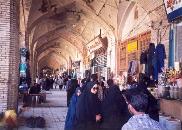
|
Vakil Bazaar
The extensive Regents Bazaar,
constructed of beautiful and
well-preserved brick, much of it from
the Safavid period, is largely of
interest for its architecture rather
than for the range of goods, although
there are a few metalwork shops selling
brass trays and the like noisily
hammered into shape on site. Built by
Mohammad Ismail Khan, Vakil ol-Molk, who
was an energetic governor of Kerman from
1859 to 1866, the Vakil caravansary with
its attractively tiled walls, adjoins
the main Vakil Bazaar.
The caravansary provides office
accommodation for bazaar merchants. The
two handsome "chimneys" are in fact wind
towers (bad-girs), which are a common
feature of Kerman, Yazd, and other
desert towns of Iran. Cool air was drawn
down to basement rooms which were used
during the scorching summer months. The
temperature in these rooms is between 20
to 30 degrees cooler than in those above
ground in summer.
Perhaps the most enchanting corner of
Kerman bazaar is the entrance to the
Ebrahim Khan Madraseh and Bath House (hamman).
Built in 1816-17 by a cousin and
son-in-law of Fath Ali Shah, Ebrahim
Khan, who was the governor of Kerman
from 1802 to 1824, the entrance portals
are decorated with gay tilework, whose
designs include peacocks, water fowl,
flowers and calligraphic inscriptions.
The interior of both buildings is worth
their entrances. The tiled and
single-story Madraseh is built round a
peaceful, cypress-shaded courtyard,
while the walls of hamman are decorated
with amusing painting said to date from
the end of the 18th century. There is a
traditional and very atmospheric tea
house inside the Vakil Bazaar, which is
called the Ghahveh Khaneh Sonnati.
|
|
|
|
 |
 |
 |
 |
 |
 |
| |
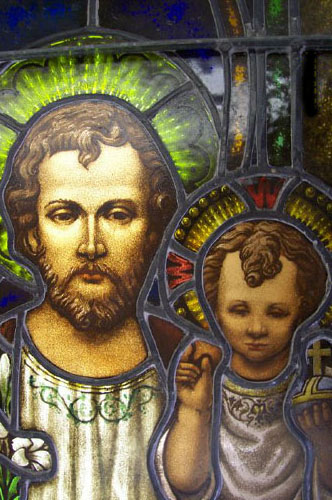
|
The Anglican Church of St. Andrew
The Anglican Church of St. Andrew, a
building easily missed from the street,
is hidden in a garden behind a doorway
in Shariati Avenue marked with the
Persian Cross characteristic of all the
Anglican churches in Iran. The small
flock seems largely to have been
forgotten by headquarters in Canterbury
except for goodwill cards at Christmas
and Easter, and fellow-believers are
assured of a warm welcome. The original
building founded by British missionaries
was destroyed in a recent earthquake,
but with a great effort the tiny
congregation built a new church in stone
in mid 80s. For a few years now they
have had to do without a minister, so a
small community of lay members sharing
the priests house take it in turn to
lead the SunDay service (in Persian).
|
|
|
|
 |
 |
 |
 |
 |
 |
| |
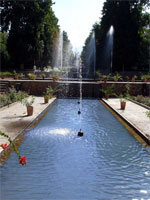
|
Mahan
Apart from Bam which you might have put
it down on your list of visits, we
recommend you to add another name, i.e.
Mahan, 35 km south of Kerman on the Bam
road, renowned for the sanctuary of a
saintly person said to have lived for a
hundred years, from 1331 to 1431: Shah
Nur od-Din Nematollah Vali, poet, sage,
sufi, and founder of Nematollahi order
of dervishes, who are quite numerous in
Iran and meet in the sanctuary of Mahan.
They are peaceful people of the
Muhammedan faith. To them life means
being uprooted; their striving is for
the return through death to their
"native land, relying on their
activities, patience and tolerance."
Nematollah was born in Aleppo, spent
much of his life in Iraq, seven years in
Mecca, then traveled to Samarqand,
Herat, and Yazd, spending the last years
of his long life here in Mahan.
The greenish-blue faience on two Qajar
minarets and the mighty Safavid cupola
stands out against the unremitting deep
blue of the sky and the elephant gray of
the surrounding mountains as a token of
mans spiritual intrusion into the
majesty of nature. The tomb and the
great assembly hall next to it do not
present any particular decoration,
except for the ceiling, which one could
easily take for a Kerman rug. The little
oratory, however, where Nematollah Vali
used to meditate, deserves attention
owing to its extraordinary interlaced
script work decoration, divided into
twelve sectors, all of different colors.
Inside the courtyard there is a well
designed small lake or body of water
surrounded by cypress trees. On the
perimeter of the shrine are glorious
colonnades which lead to the central
shrine itself. Here is a dub-shell dome,
and on the tomb itself a beautiful chest
is installed.
Mahan has also an attractive historical
garden from the Qajar period, called
Bagh-e Tarikhi (Historical Garden). The
combination of delightful scenery and
the charm of its mausoleum is very
restful.
|
|
|
|
 |
 |
 |
|
 |
|
 |
|
|
|
| Suggest your comments about nearby Sightseeing |
Private and group tours Tours , also Accommodation reservation services are available at
www.PersiaTours.com for further information , please contact us.
Use the following keywords to find this page online:
Iran Kerman, Travel Iran Kerman , Iran Kerman
vacations, Iran Kerman tourism, Iran Kerman hotels, deals,
Iran Kerman historical travel tour, Iran Kerman visitors
guide, Iran Kerman advice, Iran Kerman map, Iran
Kerman pictures, Iran Kerman information, Iran
Kerman
ratings, Iran Kerman reviews, Iran Kerman airport, Iran
Kerman weather, Iran Kerman things to do, Iran
Kerman
attractions, Iran Kerman cultural tours iran , Iran Kerman
travel to Iran, Iran Kerman Iran tours, Iran Kerman Iran
touring, Iran Kerman Iran tourism, Tour to Iran Kerman , Tours
in Iran Kerman , Iran Kerman tour operator, Adventure tours in
Iran Kerman , Business Travel to Iran Kerman , Business Trip to Iran,
Archaeology tour in Iran Kerman , Pilgrim tours in Iran Kerman ,
Persian tours Iran Kerman , cultural tours in Iran Kerman ,
geographical tours in Iran Kerman , Persia, tour to Persia, Trekking
tours in Iran Kerman , hunting tours in Iran , historical tours in Iran ,
climbing tours in Iran Iran Kerman |
|
|
|
|
 |
 |
 |




